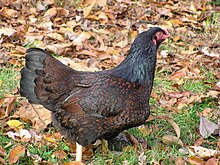This article is about the breed of chicken. For the chess opening, see Indian Defence. For games of India, see Category:Indian games.
 Dark Indian Game Dark Indian Game | |
| Conservation status | FAO (2007): not at risk |
|---|---|
| Country of origin | United Kingdom |
| Distribution | world-wide |
| Use |
|
| Traits | |
| Weight |
|
| Egg colour | light brown |
| Classification | |
| APA | English |
| EE | yes |
| PCGB | heavy: hard feather |
| |
The Indian Game is a British breed of game chicken, now reared either for meat or show. It originated in the early nineteenth century in the counties of Cornwall and Devon in south-west England. It is a heavy, muscular bird with an unusually broad breast; the eggs are brown.
In the United States the name was changed in the early twentieth century to Cornish. A white variant, the White Cornish, was developed there at about the same time, and is much used in modern industrial chicken meat production in many parts of the world, either for cross-breeding to produce hybrid broilers, or to produce fast-growing "game hens".
History
The breed was developed by Sir Walter Gilbert, of Bodmin in Cornwall, in about 1820. It was intended to be a gamecock, but had no aptitude for cockfighting.
It is recognised as "Indian Game" in Australia, by the Poultry Club of Great Britain in the United Kingdom, and by the Entente Européenne in Europe. In the United States the name was changed in 1905 to "Cornish Indian Game", and then in 1910 to "Cornish". It was accepted by the American Poultry Association in 1893.
Characteristics
The Indian Game is a large and stocky bird, short in the legs and unusually broad and deep in the breast. Some cock birds may be so short-legged and broad-breasted that they are incapable of reproducing.
Three colour variants are recognised in the United Kingdom: the dark, the original colour; the Jubilee; and the double-laced blue, which is rare. The Entente Européenne d'Aviculture et de Cuniculture and some European countries recognise the white variant in addition to these three. In the United States, the Cornish is recognised in four colours: the original dark, added to the Standard of Perfection in 1893; the white, added in 1898; the white-laced red, added in 1909; and the buff, added in 1938.
It is resistant to most common diseases of poultry, but vulnerable to parasites. The feathers are thin and hard, without down; this may render the birds susceptible to cold, which may delay breeding in early Spring.
Use
The Indian Game was bred as a gamecock, but was not successful as a fighting bird. It was found to be a good meat breed, and was much used for cross-breeding with established meat breeds such as the Dorking, Orpington and Sussex. It is a poor layer: the eggs are small and light brown; hens may lay about 80 per year.
References
- Barbara Rischkowsky, D. Pilling (eds.) (2007). List of breeds documented in the Global Databank for Animal Genetic Resources, annex to The State of the World's Animal Genetic Resources for Food and Agriculture. Rome: Food and Agriculture Organization of the United Nations. ISBN 9789251057629. Archived 23 June 2020.
- ^ Victoria Roberts (2008). British Poultry Standards: complete specifications and judging points of all standardized breeds and varieties of poultry as compiled by the specialist breed clubs and recognised by the Poultry Club of Great Britain, sixth edition. Oxford: Blackwell. ISBN 9781405156424.
- ^ Chris Graham (2006). Choosing and Keeping Chickens. London: Octopus Publishing. ISBN 9780793806010.
- ^ APA Recognized Breeds and Varieties: As of January 1, 2012. American Poultry Association. Archived 4 November 2017.
- ^ Liste des races et variétés homologuée dans les pays EE (28.04.2013). Entente Européenne d'Aviculture et de Cuniculture. Archived 16 June 2013.
- Breed Classification. Poultry Club of Great Britain. Archived 12 June 2018.
- ^ Indian Game. Rare Breeds Survival Trust. Archived 31 October 2020.
- Chickens. Poultry Club of Great Britain. Archived 9 November 2018.
- ^ J. Ian H. Allonby, Philippe B. Wilson (editors) (2018). British Poultry Standards: complete specifications and judging points of all standardized breeds and varieties of poultry as compiled by the specialist breed clubs and recognised by the Poultry Club of Great Britain, seventh edition. Chichester; Hoboken, New Jersey: Wiley Blackwell. ISBN 9781119509141.
- ^ Cornish Chicken. The Livestock Conservancy. Archived 30 October 2020.
- Australian Poultry Standards (2nd ed.). Poultry Stud Breeders and Exhibitors Victoria.
- Indian Game. Poultry Club of Great Britain. Accessed August 2021.
- Christie Aschwanden (2019). Beautiful Chickens: Portraits of champion breeds. Minneapolis: Ivy Press. ISBN 9781782407614.